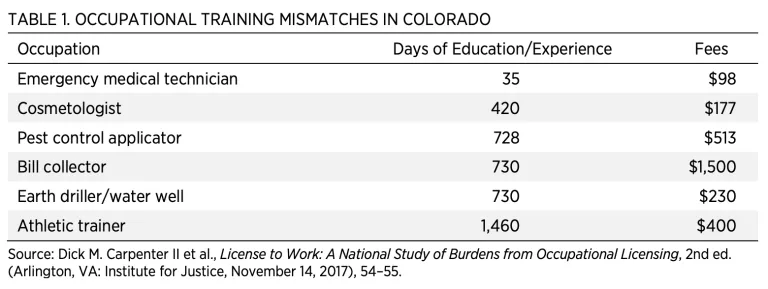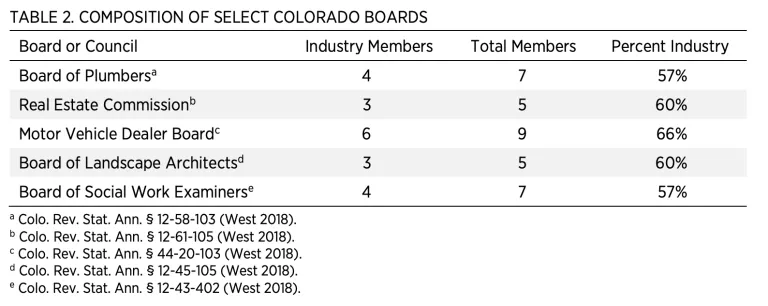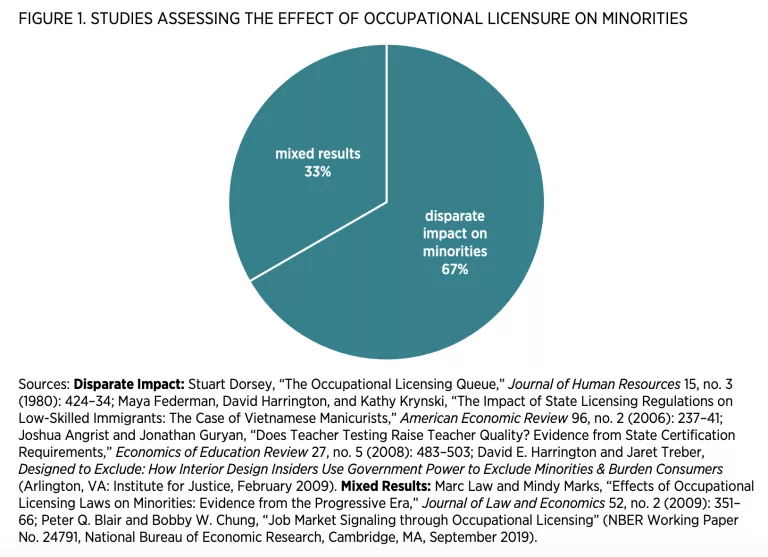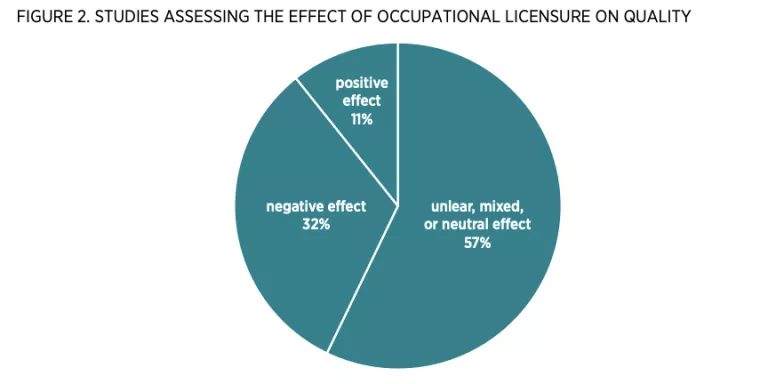- | Corporate Welfare Corporate Welfare
- | State Testimonies State Testimonies
- |
Colorado Occupational Licensing and Credential Portability
Testimony before the Colorado General Assembly, House Committee on Business Affairs & Labor
Chair Kraft-Tharp, Vice Chair Coleman, and distinguished members of the House Committee on Business Affairs & Labor:
My name is Matthew Mitchell. I am an economist and a senior research fellow at the Mercatus Center at George Mason University, where I direct the Equity Initiative. In recent years, my colleagues and I have been studying occupational licensing laws, and I am grateful for the opportunity to discuss our findings with you.
In my testimony, I wish to focus on three points:
- Licensing is a substantial barrier to employment, imposing a cost to the economy and a disparate burden on certain vulnerable populations.
- In many sectors, licensing does little to enhance either consumer safety or the quality of services; it does, however, increase prices for consumers.
- Successful reform is difficult, but not impossible. Policymakers must be able to cast conspicuous votes in the general interest while special interest power must be limited.
Licensure Is an Employment Barrier That Is Economically Costly and Individually Burdensome
Licensing represents a significant and growing barrier to work. Nationally, the share of the workforce that is required to have an occupational license has increased more than fourfold in the past 50 years. As of 2015, nearly one in five working Coloradans—17.2 percent of the state’s workforce—was required to be licensed.
As licensing burdens have increased nationwide, they seem to have depressed interstate migration of those in licensed professions. Economists Janna Johnson and Morris Kleiner estimate that between-state migration of those who are licensed is 36 percent lower than that of members of other professions.
These burdens have an economic cost. In separate research, Kleiner and Evgeny Vorotnikov estimate that, each year, licensure may cost the US economy between 1.8 and 1.9 million jobs and result in between $6.2 billion and $7.1 billion in lost output. They also estimate that licensure creates a misallocation of resources that costs the US economy between $183.9 billion and $197.3 billion. In Colorado alone, they estimate that licensure has eliminated more than 57,000 jobs, resulted in nearly $375 million in lost annual output, and created a $5.7 billion annual misallocation of resources.
Aspiring entrants to a large number of professions—ranging from travel guide and gaming supervisor to cosmetologist—are now required by the state of Colorado to obtain a government-issued license to work. It can take months and hundreds or even thousands of dollars to obtain these licenses. Among 34 low- to moderate-income occupations licensed by Colorado, the average aspiring worker is required to spend 260 days in training and pay $344 in fees before he or she may obtain a license. This does not count either the cost of the education or the income that people forgo when they spend months in often-unnecessary training. According to the Institute for Justice, Colorado’s licensing laws are the 36th most burdensome in the country.
Licensure is often arbitrary. As shown in table 1, licensing requirements often don’t match the risk posed to the public by certain professions. Compared with emergency medical technicians, aspiring cosmetologists in Colorado must undergo 12 times as many months of training; would-be bill collectors (who are unlicensed in 20 states) must complete more than 21 times as much training; and athletic trainers must complete more than 40 times as much training.

Licensing boards are dominated by members of the professions they oversee. About 80 percent of Colorado occupational licensure boards are required by law to have a majority of their members work in the professions they oversee. See table 2 for board composition data in a sample of Colorado boards. Owing to vacancies, many boards are composed entirely of industry insiders. This presents a legal concern in light of the US Supreme Court’s decision in North Carolina State Board of Dental Examiners v. FTC, which held that states may be liable for antitrust violations when boards are dominated by members of the professions they oversee and when elected officials fail to actively supervise these boards. It also creates a practical concern that boards will tend to act as industry cartels, controlling entry of new members rather than ensuring public safety.

Licensing reduces employment opportunities and has a high incidence on economically vulnerable communities. High barriers to employment pose particular difficulties to lower-skilled, lower-educated populations, to immigrants, to those with criminal records, and to those who move frequently, such as military spouses. As shown in figure 1, 67 percent of the studies that assess licensure’s disparate impact find that it has a disproportionately negative effect on minorities.

In states where the scope of licensure for low- to moderate-income occupations has grown more rapidly, there is less absolute income mobility, as measured by the chances that an individual raised in a relatively low-income household will move up the income distribution.
Those with criminal histories are particularly likely to be stymied by these laws. The Council of State Governments Justice Center estimates that nationally about 15,000 laws and regulations limit the ability of those with prior convictions to obtain state occupational licenses. Among these, 6,000 are blanket or mandatory restrictions. This means that a decades-old mistake can bar an aspiring worker from employment, even in fields that are unrelated to the original offense. Ironically, it may also land the worker back in incarceration, as unemployment has been found to be a key driver of recidivism.
Licensure presents an especially steep employment barrier for military spouses. About 35 percent of working military spouses are either licensed or certified. And compared with the broader population, military spouses are 10 times more likely to have moved across a state line in the past year. When military spouses were asked to name the biggest challenges to employment, 22 percent identified the inability to transfer their professional licenses from one state to another.This helps to explain why, in 2017, the military spouse unemployment rate was 16 percent, nearly four times the national average.
Licensure Does Not Seem to Increase Quality or Safety, but It Does Raise Prices
Licensure could increase the quality and safety of services if it were to successfully screen out low-quality workers, equip workers with the right skills to perform their jobs safely, and provide a way for negligent agents to be disciplined. On the other hand, licensure may insulate service providers from market competition, and quality tends to be enhanced by market competition. And since it raises prices and limits the quantity of providers, it might make consumers more likely to attempt the service themselves. In extreme cases, this can lead to tragedy. For example, when there are fewer electricians in an area, homeowners are more inclined to perform their own electrical work, leading to more injuries.
The most common justification for occupational licensing is that it is necessary to ensure quality and safety. However, the evidence in support of that justification is limited. In figure 2, I summarize the empirical work on licensure and quality. Nearly three-fifths of studies find that licensure either has mixed, unclear, or neutral effects on quality; one-third find a negative effect; and merely 11 percent of studies find a positive effect.

Sources: Positive: Arlene Holen, The Economics of Dental Licensing (Washington, DC: Public Research Institute, Center for Naval Analysis 1978); Roger Feldman and James W. Begun, “The Effects of Advertising: Lessons from Optometry,” Journal of Human Resources 13, supplement (1978): 247–62; Samuel Claude Martin, “An Examination of the Economic Side Effects of the State Licensing of Pharmacists,” (PhD diss., University of Tennessee, 1982). Unclear, Mixed, or Neutral: Kathryn Healey, “The Effect of Licensure on Clinical Laboratory Effectiveness” (PhD diss., University of California, Los Angeles, 1973); John J. Phelan, Regulation of the Television Repair Industry in Louisiana and California: A Case Study (Washington, DC: Federal Trade Commission 1974); John F. Cady, Restricted Advertising and Competition: The Case of Retail Drugs (Washington, DC: American Enterprise Institute, 1976); Robert J. Thornton and Andrew R. Weintraub, “Licensing in the Barbering Profession,” Industrial and Labor Relations Review 32, no. 2 (1979): 242–49; Ronald Bond et al., Effects of Restrictions of Advertising and Commercial Practice in the Professions: The Case of Optometry (Washington, DC: Federal Trade Commission, 1980); Alex R. Maurizi, “The Impact of Regulation of Quality: The Case of California Contractors,” in Occupational Licensure and Regulation, ed. Simon Rottenberg (Washington, DC: American Enterprise Institute, 1980): 26–35; Chris Paul, “Physician Licensure Legislation and the Quality of Medical Care,” Atlantic Economic Journal 12, no. 4 (1984): 18–30; Carl Shapiro, “Investment, Moral Hazard, and Occupational Licensing,” Review of Economic Studies 53, no. 5 (1986): 843–62; David S. Young, The Rule of Experts: Occupational Licensing in America (Washington, DC: Cato Institute, 1987); Morris M. Kleiner and Daniel L. Petree, “Unionizing and Licensing of Public School Teachers: Impact on Wages and Educational Output,” in When Public Sector Workers Unionize, ed. Richard B. Freeman and Casey Ichniowski (Chicago: University of Chicago Press, 1988), 305–19; D. D. Goldhaber and D. J. Brewer, “Does Teacher Certification Matter? High School Teacher Certification Status and Student Achievement,” Educational Evaluation and Policy Analysis 22, no. 2 (2000): 129–45; Morris M. Kleiner and Robert T. Kudrle, “Does Regulation Affect Economic Outcomes? The Case of Dentistry,” Journal of Law and Economics 43, no. 2 (2000): 547–82; David Blau, “Unintended Consequences of Child Care Regulations,” Labour Economics 14, no. 3 (2007): 513–38; Joshua Angrist and Jonathan Guryan, “Does Teacher Testing Raise Teacher Quality? Evidence from State Certification Requirements,” Economics of Education Review 27, no. 5 (2008): 483–503; Thomas J. Kane, Jonah E. Rockoff, and Douglas O. Staiger, “What Does Certification Tell Us about Teacher Effectiveness? Evidence from New York City,” Economics of Education Review 27 (2008): 615–31; Morris M. Kleiner et al., “Relaxing Occupational Licensing Requirements: Analyzing Wages and Prices for a Medical Service,” Journal of Law and Economics 59, no. 2 (2016): 261–91. Negative: Sidney L. Carroll and Robert J. Gaston, “Occupational Licensing: Final Report” (NTIS No. NSF/FA7704140, National Science Foundation, Alexandria, VA, October 1977); Timothy Muris and Fred McChesney, “Advertising, Consumer Welfare, and the Quality of Legal Services: The Case of Legal Clinics” (working paper no. 78-5, Law and Economics Center, University of Miami, Miami, FL, 1978); Sidney L. Carroll and Robert J. Gaston, “State Occupational Licensing Provisions and Quality of Services Received: The Real Estate Business,” Research in Law and Economics 1 (1979): 1–14; Sidney L. Carroll and Robert J. Gaston, “Barriers of Occupational Licensing of Veterinarians and the Incidence of Animal Diseases,” Agricultural Economic Research 30 (1978): 37–39; Sidney L. Carroll and Robert J. Gaston, “Occupational Restrictions and the Quality of Service Received: Some Evidence,” Southern Economic Journal 47 (1981): 959–76; Ronald S. Bond et al., “Self-Regulation in Optometry: The Impact on Price and Quality,” Law and Human Behavior 7, no. 2-3 (1983): 219–34; John E. Kwoka, “Advertising and the Price and Quality of Optometric Services,” American Economic Review 74, no. 1 (1984): 211–16; Mark C. Berger and Eugenia F. Toma, “Variation in State Education Policies and Effects on Student Performance,” Journal of Policy Analysis and Management 13, no. 3 (1994): 477; Morris M. Kleiner and Richard M. Todd, “Mortgage Broker Regulations That Matter: Analyzing Earnings, Employment, and Outcomes for Consumers,” in Studies of Labor Market Intermediation, ed. David Autor (Chicago: University of Chicago Press, 2009): 183–231.
There is abundant evidence that licensure raises prices. In a Mercatus assessment of 19 peer-reviewed studies, my colleagues and I found that licensure was associated with higher prices in all 19. Reviewing many of the same studies, Obama administration officials similarly concluded that the association between licensing and higher prices is “unequivocal.”
Successful Reform Is Difficult but Not Impossible
Licensing reform efforts are difficult to implement successfully. The consumers and the aspiring professionals who suffer from anticompetitive licensing regimes are numerous and typically politically unorganized. On the other hand, the industry insiders who benefit from these regimes are comparatively few in number and typically well organized. Economists and political scientists have long blamed this pattern of diffuse costs and concentrated benefits for the persistence of inefficient and inequitable policy. And this pattern has made licensing reform an uphill battle, even though experts across the political spectrum tend to agree that current licensing laws are inefficient and anticompetitive.
Drawing lessons from successful reform. Despite the advantages enjoyed by special interests, history affords a number of examples in which the general interest has prevailed. In areas as varied as trade, race relations, and airline policy, special interests have occasionally lost their privileges while general and diffuse interests have benefitted from a more level and open playing field.
There are a number of important lessons to draw from these cases. But perhaps the most important is that institutional reforms must limit the influence of special interests and permit policymakers to cast conspicuous votes in the general interest. The visibility of those votes should help counteract the outsize influence of special interest lobbying.
Recognition of Out-of-State Licenses
In the case of occupational licensing, several potential reforms follow this pattern. The recognition of out-of-state licenses is one particularly promising reform. Pioneered in Arizona, this allows any state residents who are currently licensed by another state to obtain an occupational license. While economists and antitrust officials have long recommended licensure portability, this proposal takes the idea a step further than other proposals. Typically, licensure portability reforms have focused on particular professions, such as nursing, and have required multiple states to agree to an interstate compact. That type of reform may still be susceptible to the sort of regulatory capture problems that have long dominated state-level licensure.
The recognition of out-of-state licenses, however, allows legislators to serve the general public by easing licensure burdens while mitigating the sort of special-interest pleading that so often dominates regulatory reform.
House Bill 20-1326 would establish an occupational credential portability program in the state of Colorado. Unlike the Arizona universal recognition law, it would not apply to all professions. But it would apply to most professions regulated by the division of professions and occupations within the department of regulatory agencies. It would permit an individual who is duly licensed by another state that requires “substantially equivalent” experience or credentials and is in good standing with that state’s regulator to obtain a Colorado occupational license.
Policymakers who value consumer protection, lower prices, and greater opportunities for employment—especially among lower-skilled and lower-educated populations—would do well to consider this reform.
Thank you for the opportunity to share my research with you today. I am happy to answer any questions you may have.
Sincerely,
Matthew D. Mitchell, PhD
Director and Senior Research Fellow, Equity Initiative, Mercatus Center at George Mason University

